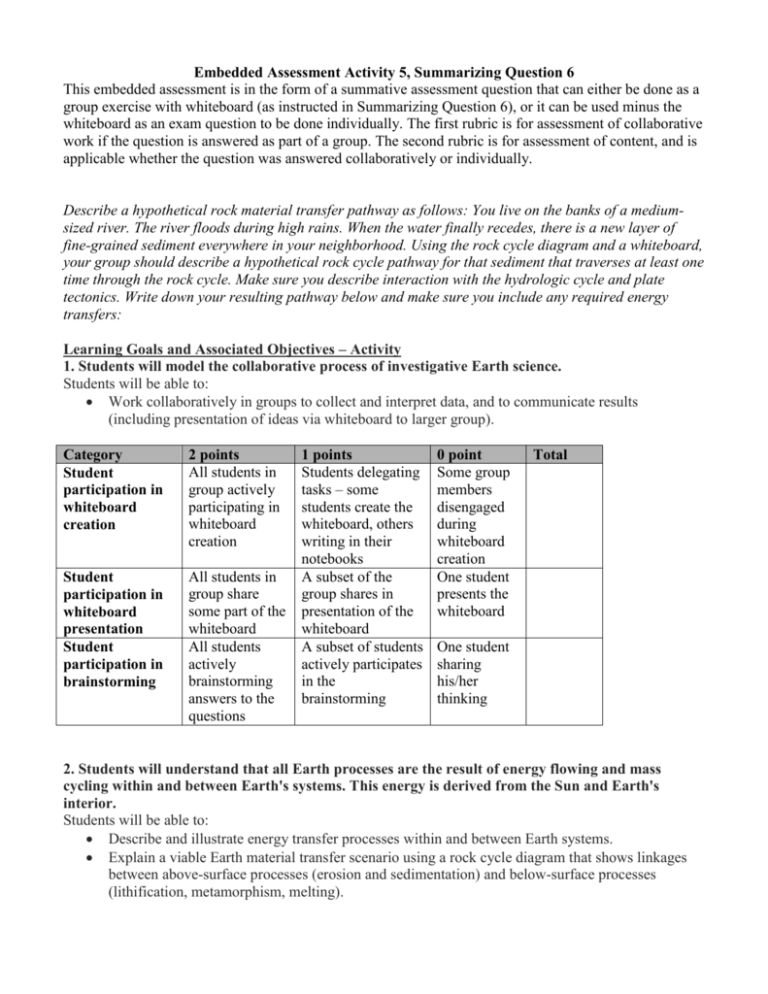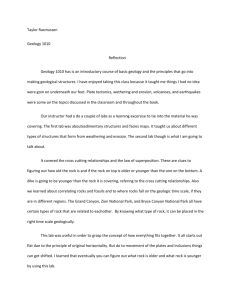Embedded Assessment Activity 5, Summarizing Question 6 This
advertisement

Embedded Assessment Activity 5, Summarizing Question 6 This embedded assessment is in the form of a summative assessment question that can either be done as a group exercise with whiteboard (as instructed in Summarizing Question 6), or it can be used minus the whiteboard as an exam question to be done individually. The first rubric is for assessment of collaborative work if the question is answered as part of a group. The second rubric is for assessment of content, and is applicable whether the question was answered collaboratively or individually. Describe a hypothetical rock material transfer pathway as follows: You live on the banks of a mediumsized river. The river floods during high rains. When the water finally recedes, there is a new layer of fine-grained sediment everywhere in your neighborhood. Using the rock cycle diagram and a whiteboard, your group should describe a hypothetical rock cycle pathway for that sediment that traverses at least one time through the rock cycle. Make sure you describe interaction with the hydrologic cycle and plate tectonics. Write down your resulting pathway below and make sure you include any required energy transfers: Learning Goals and Associated Objectives – Activity 1. Students will model the collaborative process of investigative Earth science. Students will be able to: Work collaboratively in groups to collect and interpret data, and to communicate results (including presentation of ideas via whiteboard to larger group). Category Student participation in whiteboard creation 2 points All students in group actively participating in whiteboard creation Student participation in whiteboard presentation Student participation in brainstorming All students in group share some part of the whiteboard All students actively brainstorming answers to the questions 1 points Students delegating tasks – some students create the whiteboard, others writing in their notebooks A subset of the group shares in presentation of the whiteboard A subset of students actively participates in the brainstorming 0 point Some group members disengaged during whiteboard creation One student presents the whiteboard Total One student sharing his/her thinking 2. Students will understand that all Earth processes are the result of energy flowing and mass cycling within and between Earth's systems. This energy is derived from the Sun and Earth's interior. Students will be able to: Describe and illustrate energy transfer processes within and between Earth systems. Explain a viable Earth material transfer scenario using a rock cycle diagram that shows linkages between above-surface processes (erosion and sedimentation) and below-surface processes (lithification, metamorphism, melting). Category 3 points 2 points 2 points 0 points Aboveground part of the rock cycle Students correctly illustrate/describe all rock breakdown, transportation, and depositional processes, perhaps including surface rock forming processes (e.g., extrusive volcanic rocks) Students correctly illustrate/describe most breakdown, transportation, and depositional processes, perhaps including surface rock forming processes (e.g., extrusive volcanic rocks) Students correctly illustrate/describe few breakdown, transportation, and depositional processes, perhaps including surface rock forming processes (e.g., extrusive volcanic rocks) Belowground part of the rock cycle Students correctly illustrate/describe all below-ground rock formation processes Students correctly illustrate/describe few below-ground rock formation processes Transfers through the rock cycle from above ground to below ground and vice versa Students correctly illustrate/describe all burial or uplift/erosion processes that transport material from above ground to below ground or vice versa Energy transfers within and between Earth systems Students correctly describe all sources of energy in the rock cycle, including the Sun’s role in the hydrologic cycle and Earth’s internal heat for below-ground processes Students correctly illustrate/describe most below-ground rock formation processes Students correctly illustrate/describe most burial or uplift/erosion processes that transport material from above ground to below ground or vice versa Students correctly describe most sources of energy in the rock cycle Students do not correctly illustrate/describe any breakdown, transportation, and depositional processes, and do not include surface rock forming processes (e.g., extrusive volcanic rocks) Students do not correctly illustrate/describe any below-ground rock formation processes Students do not correctly illustrate/describe any burial or uplift/erosion processes that transport material from above ground to below ground or vice versa Students do not correctly describe any sources of energy in the rock cycle Students correctly illustrate/describe few burial or uplift/erosion processes that transport material from above ground to below ground or vice versa Students correctly describe few sources of energy in the rock cycle Total







